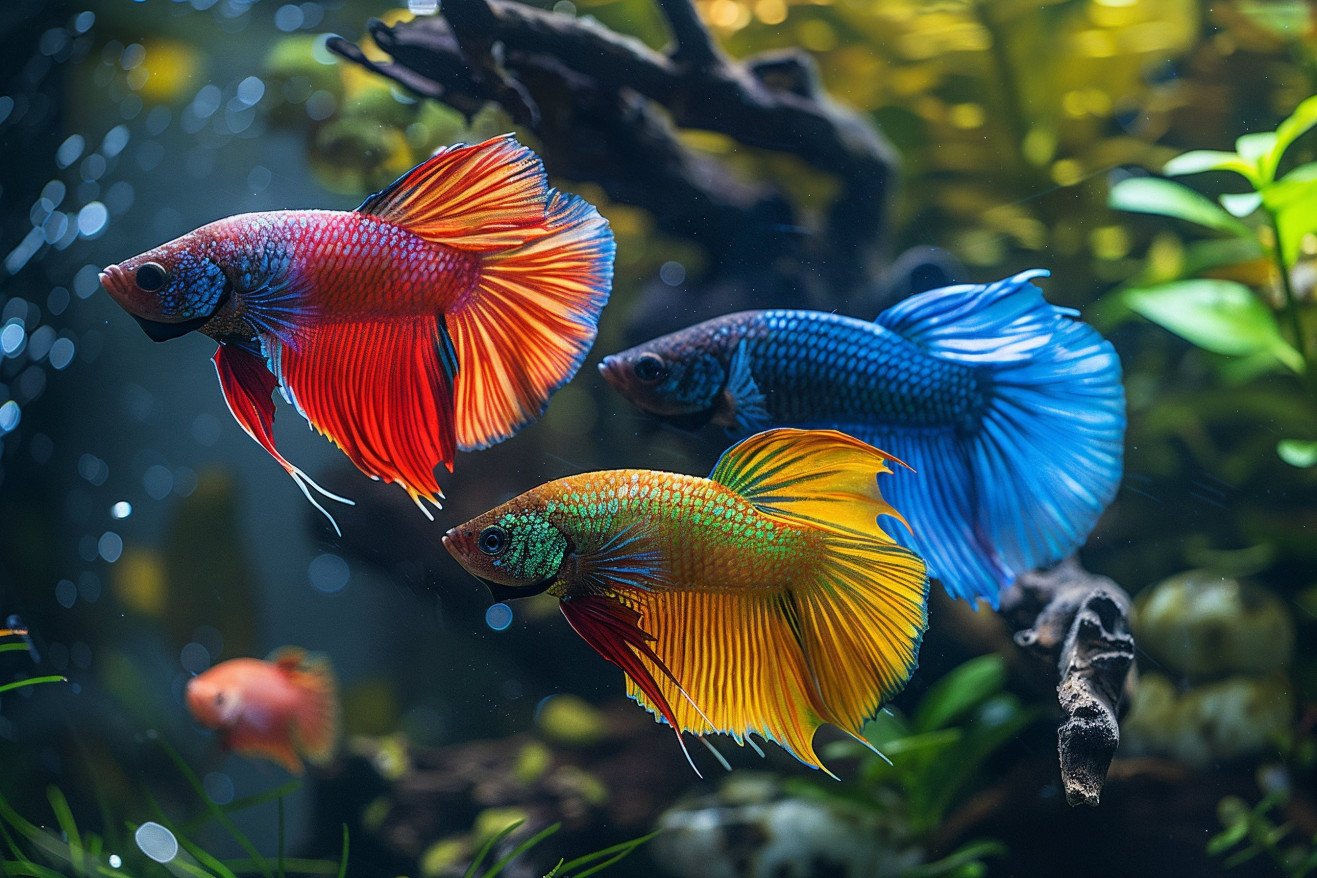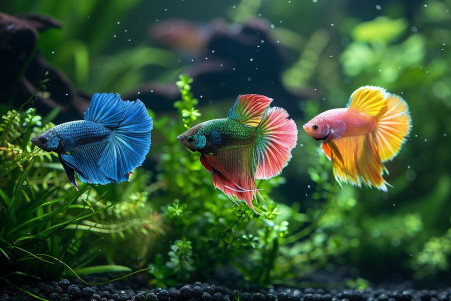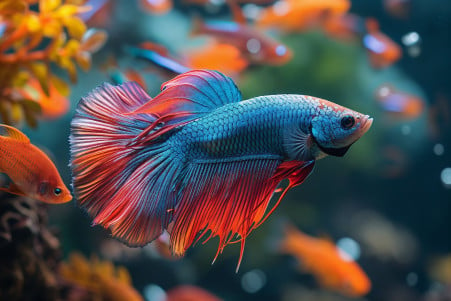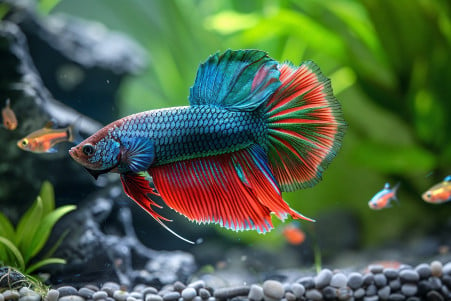Can Female Betta Fish Live Together Harmoniously? Cohabitation Considerations
5 April 2024 • Updated 5 April 2024

If you're considering setting up a sorority tank and want to know if female bettas can live together, the answer is yes. However, you need to make sure you have enough space, plants, and hiding places and territories to keep aggression and fighting to a minimum.
Drawing from the work of aquarium biologists, we'll look at the best tank setups, the behavior of female bettas, and the best tank mates to help you set up a community tank that will allow female bettas to live in a sorority. By learning what they need to thrive, you can learn how to set up a community of these colorful little fish that won't compromise their well-being.
Can female betta fish live together harmoniously?
Signs of Aggression and How to Prevent Conflict
While some aggression is normal when female bettas are setting up their pecking order, it's important to recognize signs of aggression that could lead to more serious issues. According to Tropicflow, some common signs of aggression include nipping, chasing, fin damage, and constant harassment.
The most common causes of aggression are territorial disputes, new tank additions, competition for food, and stress. In fact, one user on The Planted Tank Forum reported that a single female betta was being bullied by several other tankmates.
To prevent conflict, make sure there are plenty of breaks in the line of sight with tall plants, caves, and other decorations. This will help create multiple territories and hiding places. Also, when adding new bettas to an existing sorority, make sure that you acclimate the new fish properly to avoid territorial disputes.
If certain fish continue to be aggressive even after you've made these changes, you may need to remove them from the sorority before they cause serious problems. However, with careful observation and changes, most conflicts can be managed so that female bettas can live together harmoniously.
The Best Tank Conditions for a Successful Betta Sorority
One of the most important factors in creating a successful betta sorority is the tank setup. According to Bettafish.org, the minimum tank size for 4-5 bettas is 10 gallons, with an additional 3 gallons for each additional betta. Modestfish.com notes that bigger is always better, as larger tanks have more water volume, which makes it easier to maintain water parameters and reduces stress.
The best tank shape is long and shallow, as this maximizes the surface area and ensures that each fish has plenty of space. Micro Aquatic Shop suggests that the tank be heavily planted with tall stem plants, floating plants, caves, and driftwood to create hiding places and block lines of sight, which reduces aggression and ensures that each fish has its own territory.
In addition to these factors, it’s important to have the right equipment, including heaters and filters, and to do weekly partial water changes to maintain the best water quality. Modestfish.com also suggests that you consider a bare-bottom tank or a fine substrate to make maintenance easier. With the right setup, female bettas can live happily in a sorority. The next step is to make sure that you choose and introduce your new fish carefully.
How to Choose and Add New Betta Sorority Members
If you're looking to add new female bettas to an existing sorority, it's important to choose the right fish and introduce them in a way that minimizes territorial issues. According to Better Bettas, the best chance of success comes from adding young female bettas from the same spawn, or "sisters". Meanwhile, the thisbirdhasasong blog suggests choosing at least 5 female bettas that are close in size, health, and type, such as halfmoons, crowntails, and veil tails.
When it comes to adding new fish, it's important to add them all at once instead of one at a time. If you add one fish first, it may claim the entire tank as its territory and become aggressive when other fish are added. Adding them all at once ensures that each fish has an equal chance to claim their own territory and establish their place in the community.
The acclimation process is also important. As recommended on the Betta Fish Forum, new fish should be floated, drip acclimated, and then released into the tank at the same time. This will help reduce stress and territorial issues. Keep a close eye on the sorority for at least a week, and be prepared to remove any fish that are too aggressive to ensure that the peace is maintained. With the right care, you can successfully grow your female betta community.
Other Tank Mates for Female Betta Sororities
While this article has focused on how to successfully set up a female betta sorority, it's also important to discuss other tank mates that can live peacefully with these beautiful fish. According to Bettafish.org, good tank mates include other small, peaceful community fish like tetras, rasboras, and cory catfish. However, it's important to avoid colorful or aggressive fish that might cause bettas to become territorial.
Fishkeeping World says bottom-dwelling fish like kuhli loaches are good tank mates because they can act as a clean-up crew without causing any aggression. Shrimp and snails can also be kept with a betta sorority as long as there are plenty of places for them to hide. As Splashy Fish warns, keeping too many fish in a tank can lead to stress and aggression, so it's important to keep the tank stocked at a moderate level.
With the right tank mates, your female betta sorority can live in a peaceful environment. The next step is to make sure you know how to prevent and treat any of the common betta fish diseases that may pop up.
How to Prevent and Treat Common Betta Diseases
Symptoms of common betta diseases include lethargy, loss of appetite, faded colors, labored breathing, and clamped fins, which are associated with fin rot, ich, velvet, columnaris, dropsy, and swim bladder issues.
To avoid these diseases, new fish should be quarantined and water quality should be maintained. As one Betta Fish Forum user found out, a single sick betta can spread disease to an entire sorority, so it's important to keep the fish in a low-stress environment that will help them maintain their natural immunity.
If your fish do get sick, treatments like salt baths, commercial medications, and natural remedies can be used to treat the specific disease. However, the sooner you catch the disease, the better the chances of treating it and preventing it from spreading. With the right care, you can ensure that your female betta sorority stays healthy for years to come.
Long-Term Care and Maintenance for a Successful Sorority
Keeping a successful female betta sorority will require regular, attentive care. This includes weekly water changes of 25-50% to maintain water quality, as well as a high-protein diet that's fed in small portions 2-3 times a day. You'll also want to keep up with trimming and rearranging plants and decorations to keep the tank looking fresh and to minimize territorial behavior.
You'll also want to keep a close eye on the fish and be ready to remove any fish that are showing signs of aggression that won't stop before they can do any damage. As the sorority continues to grow, you may also need to move the fish to a larger tank to make sure that everyone has enough space and hiding spots. If you're willing to put in the work, your female betta sorority can continue to live together successfully.


